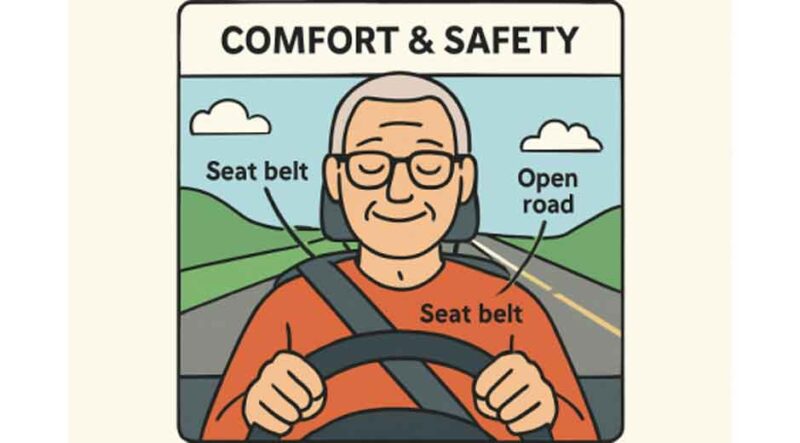Table of Contents
- Regular Health Checkups
- Driver Safety Courses
- Vehicle Safety Technologies
- Alternative Transportation Options
- Staying Informed on Traffic Laws
Introduction
As we grow older, maintaining our ability to drive safely can make a significant difference to our quality of life. Proactively addressing the unique challenges that come with age is crucial for mature drivers who want to stay safe and independent on the road. From prioritizing health checkups to adapting to evolving traffic laws and embracing advanced vehicle technologies, mature drivers have a wealth of resources at their disposal to help maintain confidence and comfort while driving. Notably, https://www.thehartford.com/aarp/car-insurance is designed specifically for older adults, offering specialized guidance, support, and insurance benefits tailored to mature drivers. Understanding these options and applying practical strategies will help ensure peace of mind, safety, and continued independence for years to come.
This comprehensive guide explores in-depth practical tips and valuable resources available for mature drivers. By following the recommendations outlined in this article, older adults can make informed decisions that promote safe driving, bolster self-confidence, and help them remain active, connected, and independent members of their community.
Regular Health Checkups
Overall wellness is the foundation of safe driving, and for mature drivers, regular health evaluations are essential. Age can impact various aspects crucial to driving, such as vision, hearing, reflexes, and cognitive function. Conditions like cataracts, macular degeneration, and glaucoma gradually diminish vision, which is vital for identifying road signs and hazards, especially after dusk or during inclement weather. Annual comprehensive eye exams can help detect these issues early, providing an opportunity to manage symptoms or seek treatments that preserve driving abilities for a longer period.
Hearing loss is another common concern. Diminished hearing can make it difficult to detect sirens or horns, which are essential for reacting promptly to emergencies. Regular hearing assessments ensure early intervention and possible solutions, such as hearing aids or specialized devices. In addition, mature drivers often take multiple medications for chronic illnesses. Some medicines may cause drowsiness or slow response times, so it’s essential to review your medication schedule and side effects with a healthcare provider. The National Highway Traffic Safety Administration (NHTSA) emphasizes the importance of regular health checkups in its comprehensive guidance for older drivers, which can be found here: Driving Safely While Aging Gracefully. Prioritizing these evaluations keeps drivers safer and empowers them to make informed, timely adjustments to their routines or driving habits as needed.
Driver Safety Courses
Staying up to date with the latest driving techniques and traffic regulations is another smart move for mature drivers. Enrolling in a defensive driving or driver safety course—especially one specifically designed for older adults—can have a profound impact on overall driving ability and confidence. These courses revisit the fundamentals of safe driving, incorporate strategies for adjusting to age-related changes, and highlight common risk factors such as reduced night vision or slower reaction times.
Courses like the AARP Smart Driver Course focus not only on reinforcing rules of the road but also provide instruction on navigating complex traffic situations, newer vehicle technologies, and adapting driving habits to fit current needs. Many mature drivers who have completed these courses report feeling better prepared to respond calmly to unexpected events or changes in driving environments. Research conducted by AARP shows a significant portion of graduates became more aware of their limitations and strengths, and as a result, felt safer while driving. As an added benefit, many auto insurance providers recognize these educational efforts by offering discounts to drivers who complete recognized safety courses.
Vehicle Safety Technologies
Modern vehicles are equipped with technologies designed to make driving safer and less stressful, which can be a real asset for mature drivers. Advanced driver-assistance systems (ADAS) are evolving rapidly, introducing functions that help with everything from detecting vehicles in blind spots to automatically applying brakes to prevent collisions. These innovations not only support drivers in avoiding accidents but can also make the act of driving less physically and mentally demanding.
Recommended Vehicle Safety Features:
- Blind Spot Warning Systems: These systems utilize sensors to detect and alert the driver to other cars in adjacent lanes that may not be visible in the mirrors, thereby reducing the risk of dangerous lane changes.
- Lane Departure Warnings: If the vehicle unintentionally moves out of its lane, these systems provide immediate alerts, helping the driver stay properly aligned within road markings.
- Rear Cross Traffic Alerts: These warnings alert drivers to oncoming vehicles or pedestrians when reversing out of parking spaces, helping to prevent collisions in busy lots or driveways.
- Automatic Emergency Braking: Utilizing sensors and cameras, these systems detect potential impending collisions and automatically apply the brakes if the driver fails to react in time, thereby significantly reducing the risk of rear-end accidents.
Embracing new vehicle technologies can make a dramatic difference in comfort and confidence behind the wheel for older drivers. These features often function as a second set of eyes and reflexes, reducing stress, enhancing overall control, and boosting self-assurance during complex driving situations. For a thorough overview of the most recommended technologies,
Alternative Transportation Options
There may come a time when driving isn’t ideal—or even possible—for safety or health reasons. Fortunately, today’s communities are more interconnected than ever, providing mature adults with a variety of reliable transportation options for remaining mobile and engaged. Planning during this transition helps minimize disruption to daily life and reduces anxiety around giving up the car keys.
Popular Alternatives:
- Public Transit: Local bus and rail systems have become increasingly accessible and comfortable for older adults, offering discounted fares and user-friendly schedules that make errands, medical appointments, and social visits feasible without the need for driving.
- Ride-Sharing Services: Services like Uber and Lyft provide flexible, on-demand transportation—just a smartphone tap away. These options eliminate the challenges of parking and provide the peace of mind that comes with 24/7 availability, even for those who only need the service occasionally.
- Community Shuttle Programs: Many towns and nonprofits offer special shuttle, paratransit, or volunteer driver programs designed to enhance senior mobility. These programs are specifically tailored to pick up and drop off seniors at their front doors, which is particularly helpful for those with limited mobility or medical needs.
The NHTSA recommends developing a personal or family transportation plan before the need arises, allowing mature adults to maintain active lives and social connectivity even when driving is not an option. Proactively discussing and organizing a plan with loved ones ensures a smooth transition if changes become necessary.
Staying Informed on Traffic Laws
Traffic laws and regulations are continually evolving, and mature drivers need to stay up to date to avoid accidental infractions and adhere to best practices on the road. Annual reviews of updated driving laws, local traffic rules, and common signage can help prevent costly or dangerous mistakes. Many states offer free updated handbooks online, and some departments of motor vehicles (DMVs) even require periodic knowledge tests after a certain age.
- Set aside time yearly to review the latest driving laws, new or changed road signs, and right-of-way rules in your state or region.
- Sign up for newsletters or alerts from your local DMV to receive direct updates regarding new requirements, legislation, or significant policy changes.
- Participate in local workshops, seminars, or senior driving events to get hands-on reviews and answers to any new safety questions.
Ultimately, making smart choices as a mature driver is a continual process—a combination of monitoring personal health, updating driving education, leveraging innovative vehicle tech, and creating flexible transportation plans. By using these strategies and accessing specialized support, mature drivers can continue to enjoy the freedom, independence, and safety they value every time they get behind the wheel.








